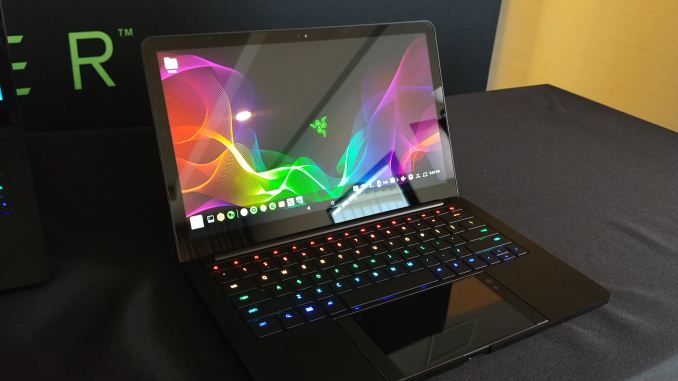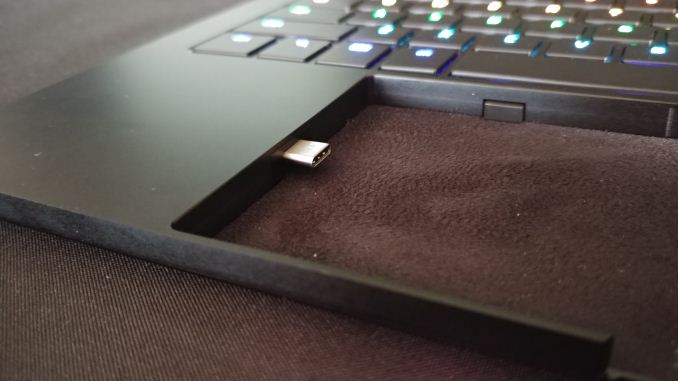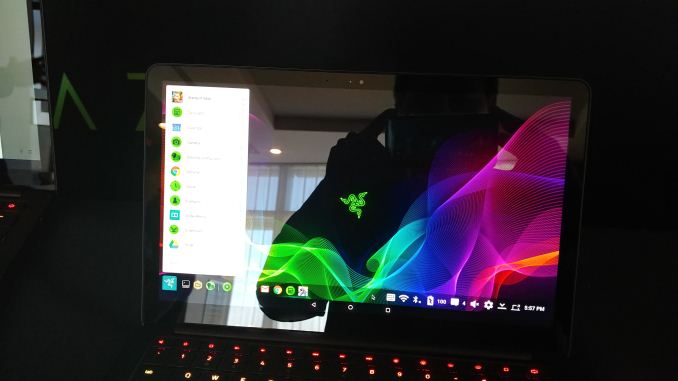Razer at CES 2018: Project Linda, Two Minutes Hands-On
by Ian Cutress on January 22, 2018 2:00 PM EST
At the start of CES, Razer announced Project Linda: a clamshell accessory for the Razer Phone that turns the smartphone into an Android-based laptop. The idea is that the phone is inserted into where the mousepad is, with the smartphone screen being used as the mousepad, the CPU, the GPU, and what the clamshell provides is a keyboard, USB and other ports, and a touch display similar in resolution to the smartphone, and some extra storage/battery, but at 13-inches. Some of the key features of the smartphone, such as the front-facing speakers, are used for audio. Ultimately this is meant to be for gamers that want to play Android games on a bigger screen with a mouse and keyboard, but still have something on the go that is better than a standard phone for standard workday things.
At the Razer suite, there were a couple of prototypes in action. Despite the software being nearly there, the hardware, for the most part, was done and fully working. The keyboard is RGB backlit, using chiclet-style keys, and the display (while not 120 Hz) was very bright. With the phone installed, it weighed about the same as my 13-inch laptop, though it was noticeable that all the weight was in the smartphone. Without the smartphone installed, it was very light.
One key feature I spent some time looking at was the mounting mechanism for the smartphone. Razer had lined the docking bay with a felt so as not to scratch the smartphone when it is inside, and in order to enable the USB Type-C connection, there is a button on the keyboard that forces a motor to protrude a USB Type-C connector. This is best displayed in a video:
To be honest, the noise of the motor was good. However, there were a few concerns. With the shape of the Razer phone, it could obviously be put in four different ways: the right way, the right-way-up but the wrong way around, the wrong way up and the right way around, or just the wrong way altogether. Because the motor that pushes the connector is based on the keyboard and not from the smartphone, there would be no way to save either device if the smartphone was put in incorrectly. Arguably if the phone was just upside down, the USB-C would still go in, but the user would not have a touch-pad, but the wrong way around would certainly break *something*. When discussing with engineers, there was no obvious solution to avoid users accidentally doing this, and the advice was ‘don’t’.
There are still a number of bugs to sort out on the software, but Razer expects Project Linda to be ready to go, perhaps in Q2. While it won’t be applicable for my user workload, and Razer ultimately targeting a small market (i.e. Razer Phone owners only) that also have the need for an Android laptop/gaming device, Razer is fully confident about enhancing its ecosystem. Unconfirmed rumors around Razer’s next mobile device point to a Q3 launch, with perhaps Linda focusing on that as a primary attachment device. We were unable to confirm these rumors.



















21 Comments
View All Comments
Pinn - Monday, January 22, 2018 - link
s/Razer/Apple/gNXTwoThou - Monday, January 22, 2018 - link
Could they do something simple, like put a magnet in one of the corners of the phone to identify it's in the correct spot?dakishimesan - Tuesday, January 23, 2018 - link
I was thinking the same. Or use a light sensor to verify that there is a hole in Front of where its port comes out and not a wall.Lord of the Bored - Tuesday, January 23, 2018 - link
Isn't the phone already out in the wild? Little late to be changing the design....
Though am I alone in thinking that this is really a non-issue? It isn't exactly rocket science here. We should be able to assume that the user knows how to line a tab up with a slot. Surely if this mechanism fails catastrophically it is the user's fault and not Razer's?
Alexvrb - Tuesday, January 23, 2018 - link
After the engineers told you their genius solution was "don't", here's the first thing that came to mind:"What happens if you sell a device to the public that isn't idiot proof?"
"Don't do that."
Lord of the Bored - Wednesday, January 24, 2018 - link
If we simply ASSUME that the entire system needs to be built for knuckle-dragging neanderthals incapable of comprehending that their phone should be inserted with the tab facing the slot, it wouldn't be very hard at all to mount the connector atop a button so that the docking system aborts if there's an abnormal pressure(such as the port pressing against a solid surface instead of a hole).It still won't stop them from cramming a paper clip into the connector, or yanking the computer out of the docking unit without retracting the connector first, but it will protect against THIS PARTICULAR flavor of idiocy.
Nothing is foolproof. I am sure the idiots would even find a way to damage a system that relied purely on inductive coupling for data transfer.
Ktracho - Monday, January 22, 2018 - link
I guess I'm old fashioned in that I prefer using a desktop computer. However, there are times when a desktop computer doesn't work, such as when I need to show something to someone in a different room, or when my office is being used as a guest room (usually for several days at a time). It's at times like that that I wish I had something like this with a remote desktop app. I wouldn't use a laptop often enough to justify buying one, though I don't know how much this Razer dock is projected to cost. Still, it would be one less computer to have to keep charged up and be updating from time to time.WorldWithoutMadness - Monday, January 22, 2018 - link
Haha, it's Razer, you can easily buy budget laptop and remote desktop all the same.Also, you are mistaken that this is powered solely by the phone. This also have a built in battery so you have to charge it from time to time.
https://www.razerzone.com/projectlinda
SeannyB - Monday, January 22, 2018 - link
> "Ultimately this is meant to be for gamers that want to play Android games on a bigger screen with a mouse and keyboard"... What are these games? Is it that Tencent MOBA? Are there competitive shooters with mouse/KB support? I'm not very hip to mobile gaming so I'd appreciate any enlightenment on what kind of games the Razer Phone and Project Linda are actually made for.
PeachNCream - Monday, January 22, 2018 - link
I play quite a few mobile games these days, moreso than I play games on my PC, but I don't see many cases where a touchpad and keyboard would be beneficial or even could be configured in a game to make play easier or better. I honestly think the best uses of Project Linda are for more mundane tasks that require lengthy data entry. The problem with the marketing of Linda is that the phone is from Razer and was advertised as appealing to gamer types so a productivity tool like this is going to have to get cloaked in marketing that appeals to the phone's target audience. The other side of that is that maybe the hardware has to be put into place first before app developers start making games that will use it.